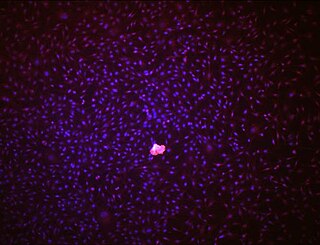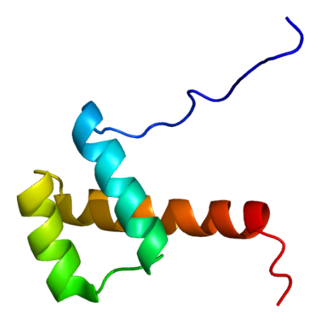Related Research Articles

A homeobox is a DNA sequence, around 180 base pairs long, that regulates large-scale anatomical features in the early stages of embryonic development. Mutations in a homeobox may change large-scale anatomical features of the full-grown organism.
Lymphangiogenesis is the formation of lymphatic vessels from pre-existing lymphatic vessels in a method believed to be similar to angiogenesis.

Schlemm's canal, also known as the canal of Schlemm, and as the scleral venous sinus, is a circular lymphatic-like vessel in the eye. It collects aqueous humor from the anterior chamber and delivers it into the episcleral blood vessels. Canaloplasty may be used to widen it.

Endothelial stem cells (ESCs) are one of three types of stem cells found in bone marrow. They are multipotent, which describes the ability to give rise to many cell types, whereas a pluripotent stem cell can give rise to all types. ESCs have the characteristic properties of a stem cell: self-renewal and differentiation. These parent stem cells, ESCs, give rise to progenitor cells, which are intermediate stem cells that lose potency. Progenitor stem cells are committed to differentiating along a particular cell developmental pathway. ESCs will eventually produce endothelial cells (ECs), which create the thin-walled endothelium that lines the inner surface of blood vessels and lymphatic vessels. The lymphatic vessels include things such as arteries and veins. Endothelial cells can be found throughout the whole vascular system and they also play a vital role in the movement of white blood cells
Chordin is a protein with a prominent role in dorsal–ventral patterning during early embryonic development. In humans it is encoded for by the CHRD gene.

The nuclear receptor 4A3 (NR4A3) also known as neuron-derived orphan receptor 1 (NOR1) is a protein that in humans is encoded by the NR4A3 gene. NR4A3 is a member of the nuclear receptor family of intracellular transcription factors.

Hematopoietically-expressed homeobox protein HHEX is a protein that in humans is encoded by the HHEX gene and also known as Proline Rich Homeodomain protein PRH.

Prospero homeobox protein 1 is a protein that in humans is encoded by the PROX1 gene. The Prox1 gene is critical for the development of multiple tissues. Prox1 activity is necessary and sufficient to specify a lymphatic endothelial cell fate in endothelial progenitors located in the embryonic veins.

Homeobox protein OTX2 is a protein that in humans is encoded by the OTX2 gene.

Homeobox protein SIX3 is a protein that in humans is encoded by the SIX3 gene.

Homeobox protein goosecoid(GSC) is a homeobox protein that is encoded in humans by the GSC gene. Like other homeobox proteins, goosecoid functions as a transcription factor involved in morphogenesis. In Xenopus, GSC is thought to play a crucial role in the phenomenon of the Spemann-Mangold organizer. Through lineage tracing and timelapse microscopy, the effects of GSC on neighboring cell fates could be observed. In an experiment that injected cells with GSC and observed the effects of uninjected cells, GSC recruited neighboring uninjected cells in the dorsal blastopore lip of the Xenopus gastrula to form a twinned dorsal axis, suggesting that the goosecoid protein plays a role in the regulation and migration of cells during gastrulation.

Homeobox protein SIX2 is a protein that in humans is encoded by the SIX2 gene.

Ventral anterior homeobox 1 is a protein that in humans is encoded by the VAX1 gene.

Edward Michael De Robertis is an American embryologist and Professor at the University of California, Los Angeles. His work has contributed to the finding of conserved molecular processes of embryonic inductions that result in tissue differentiations during animal development. He was elected to the National Academy of Sciences in 2013, worked for the Howard Hughes Medical Institute for 26 years, and holds a Distinguished Professor at the University of California, Los Angeles. In 2009 Pope Benedict XVI appointed De Robertis to a lifetime position in the Pontifical Academy of Sciences, and in 2022 Pope Francis appointed him Councillor of the Academy for four years.
Lymph sacs are a part of the development of the lymphatic system, known as lymphangiogenesis. The lymph sacs are precursors of the lymph vessels. These sacs develop through the processes of vasculogenesis and angiogenesis. However, there is evidence of both of these processes in different organisms. In mice, it is thought that the lymphatic components form through an angiogenic process. But, there is evidence from bird embryos that gives rise to the idea that lymphatic vessels arise in the embryos through a vasculogenesis-like process from the lymphangioblastic endothelial precursor cells.
In molecular biology, Six3OS1 is a long non-coding RNA. It was originally identified in the murine embryonic and postnatal retina. It is located in the distal promoter region of the gene encoding Six3, a homeodomain transcription factor. It regulates the activity of Six3 in the developing mouse retina, by binding to transcriptional co-regulators of Six3 and to histone modification enzymes and acting as a transcriptional scaffold.

Rosa Susan Penelope Beddington FRS was a British biologist whose career had a major impact on developmental biology.

Retinal homeobox protein Rx also known as retina and anterior neural fold homeobox is a protein that in humans is encoded by the RAX gene. The RAX gene is located on chromosome 18 in humans, mice, and rats.

Hox genes play a massive role in some amphibians and reptiles in their ability to regenerate lost limbs, especially HoxA and HoxD genes.
A developmental signaling center is defined as a group of cells that release various morphogens which can determine the fates, or destined cell types, of adjacent cells. This process in turn determines what tissues the adjacent cells will form. Throughout the years, various development signaling centers have been discovered.
References
- 1 2 "ACAL, Académicos 2019-2020 | ACAL". www.acal-scientia.org.
- ↑ Oliver, G., Gosset, G., Sanchez-Pescador, R., Lozoya, E., Ku Lailig, M.,Flores, N., Becerril, B., Valle, F., & Bolivar, F. (1987). Determination of the nucleotide sequence for the E. coli K12 Glutamate synthase structural genes. Gene 60, 1-11.
- ↑ De Robertis, E.M., Oliver, G., & Wright, C.V.E. (1990). Homeobox genes and the analysis of vertebrate development. Scientific American 263, 46-52.
- ↑ Oliver, G., Wright, C.V.E., Hardwicke, J., & De Robertis, E. (1988). A gradient of homeodomain protein in developing forelimbs of Xenopus and mouse embryos. Cell 55, 1017-1024
- ↑ Oliver, G., Sosa-Pineda, B., Geisendorf, S., Spana, E.P., Doe, C.Q., & Gruss, P. (1993). Prox1, a prospero-related homeobox gene expressed during mouse development. Mech Dev.44, 3-16.
- 1 2 "AAAS Members Elected as Fellows | American Association for the Advancement of Science". www.aaas.org.
- ↑ "New insight offered in holoprosencephaly". UPI.
- 1 2 Doss, Will. "Stem Cells Lead to Better Understanding of Retinal Development | Northwestern Medicine Magazine".
- ↑ Wigle, J.T. and Oliver, G. (1999). Prox1 function is required for the development of the murine lymphatic system. Cell 98, 769-778.
- ↑ Wigle, J.T., Harvey, N., Detmar, M., Lagutina, I., Grosveld, G., Gunn, M.D., Jackson, D.G., and Oliver, G. (2002). An essential role for Prox1 in the induction of the lymphatic endothelial cell phenotype. EMBO J 21, 1505-1513.
- ↑ "Leaky lymphatics lead to obesity in mice". ScienceDaily.
- ↑ Schneider, Martin; Conway, Edward M.; Carmeliet, Peter (October 15, 2005). "Lymph makes you fat". Nature Genetics. 37 (10): 1023–1024. doi:10.1038/ng1005-1023. PMID 16195715. S2CID 66017 – via www.nature.com.
- ↑ Self, M., Lagutin, O., Bowling, B., Hendrix, J., Cai, Y., Dressler, G. and Oliver, G. (2006). Six2 activity is required for suppression of inductive signals and progenitor cell renewal in the developing kidney. EMBO J, 25, 5214-28.
- ↑ Lagutin, O., Zhu, C., Kobayashi, D., Topczewski, J., Shimamura, K., Puelles, L., Russell, H.R., McKinnon, P., Solnica-Krezel, L. and Oliver, G. (2003). Six3 repression of Wnt signaling in the anterior neuroectoderm is essential for vertebrate forebrain development Genes & Dev 17, 368-379
- ↑ Liu, W., Lagutin, O., Swindell, E., Jamrich, M., and Oliver, G. (2010). Neuroretina specification in mammals requires Six3-mediated suppression of Wnt8b in the anterior neural plate. J Clin Invest, 120, 3568-3577.
- ↑ "Rethinking Cardiac Repair After Injury - News Center". 9 December 2020.
- ↑ María De Los Ángeles Orfila (27 December 2020). "Uruguayo busca cómo reparar el corazón luego de un infarto" [Uruguayan seeks how to repair the heart after a heart attack]. El País .
- ↑ "Meritorious Awards - North American Vascular Biology Organization".